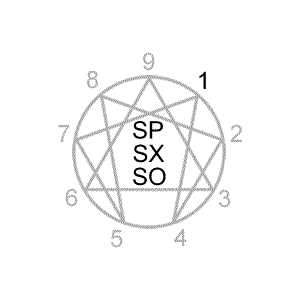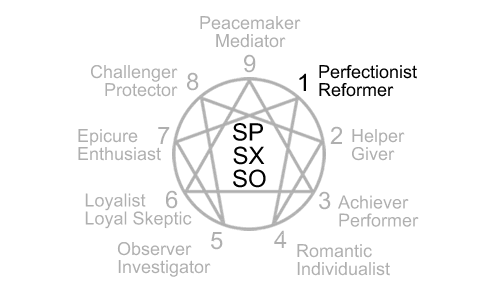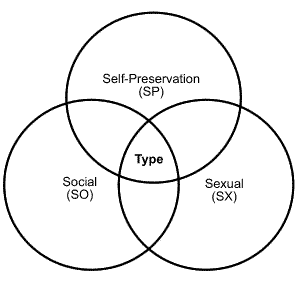Enneagram Type 1 Instinctual Subtypes: SP 1, SX 1, SO 1
The core focus of Enneagram type 1

Freedom consists not in doing what we like, but in having the right to do what we ought.
- Pope John Paul II
Early in life we develop an initial belief about ourselves and a compensation for that self-belief.
-
Type 1 Initial Self-Belief: “I am unacceptable as I am.”
Type 1 Compensation: "I must monitor, correct, and improve myself in order to be acceptable and remain above criticism."
Over time this gets generalized beyond the self into a core focus that also shapes how we perceive and interact with the world at large.
-
Type 1 Core Focus: Acceptability comes from doing things right and acting appropriately according to internalized standards for what that is. This requires I discern what’s right and monitor, correct, and improve my behavior so I don’t fall short of these standards. Others should do the same.
Personality characteristics that might arise from the type 1 core focus include:
- Monitors and corrects self-behavior by way of an Inner Critic
- Avoids making mistakes that can be criticized by others
- Compares the world to standards for how things should be
- Tends to look for one right way of doing things
- Strives toward an ideal of perfection
- Attention goes to what needs to be corrected or improved
- Critical of others when they disregard implied rules of behavior
- Tries to be good by modeling appropriate behavior
- Feels responsible for getting things right
Enneagram type 1 instinctual subtypes

The Enneagram instincts are self-preservation (sp), sexual (sx), and social (so). The sexual (sx) instinct is also called the intimate or one-to-one instinct.
The instincts are traditionally used to define three instinctual subtypes or variations of a basic type (e.g., SP 1, SX 1, and SO 1). One of these three subtypes is called the counter-type because it can look different from the basic type.
Below are brief descriptions of the three type 1 instinctual subtypes.
SP 1 - Worry, Anxiety: worries about consequences resulting from things not being done right; avoids mistakes and doing things wrong so as not to be personally blamed or criticized; obsesses about details and likes to be prepared.
SX 1 - Zeal, Jealousy (counter-type): desire to reform people or society to the “right way” to be or do; feels entitled to what’s been “earned” through hard work and high ideals; angry and resentful of those who haven’t earned what they receive.
SO 1 - Rigidity, Non-Adaptable: already knows the “right way” so no need to adapt to what others say is “right”; provides example by modeling how one should be; sense of superiority can come from criticality of others for not behaving the right way.
While an individual may be identified with type 1 in general, that same individual may be more specifically identified with one of the three instinctual subtypes as well.
A more recent approach to using the instincts is instinctual variant stacking which can be used independent of Enneagram type.
What Enneagram authors say about type 1 instinctual subtypes

Below are Enneagram 1 subtype description samplings from some popular or well-known Enneagram authors. Click on the sources after the descriptions to further explore these interpretations.
-
In the average range, Self-Preservation Ones tend to worry about their material well-being, both in terms of finances and health, and they often castigate themselves for not working hard enough.1
In the average range, Sexual Ones want a flawless relationship with an idealized partner.1
In the average range, Social Ones believe that they represent objective values, social standards, and that they speak for others.1
-
Anxiety (Worry) about Self-preservation: Ones worry about not being perfect, about not deserving to survive, and particularly about making a mistake that would jeopardize survival.2
Jealousy (Heat) in One-to-One Relationships: Jealousy takes the form of monitoring the mate’s actions and of critically judging whatever comes between the self and the mate.2
Inadaptability in Social Relationships: Inadaptability comes about through the confusion between personal desires and the need to rigidly align with a correct social position.2
-
Self-Preservation Ones: Characterized by a tendency towards worry and negative anticipation, especially as it relates to material well-being. They fret about how to avoid making mistakes that could jeopardize survival.3
Intimate Ones: Have high expectations based on having idealized their beloved. One’s reaction is jealous judgment if their beloved acts in less-than-ideal ways.3
Social Ones: Characterized by a preoccupation with rules and how they should apply to (other) people’s behavior. Tend to moralize and apply old standards inflexibly to each new situation.3
-
Self-Preservation Type 1 by Beatrice Chestnut
Social Type 1 by Beatrice Chestnut
Sexual Type 1 by Beatrice Chestnut
Click here to see this video on YouTube.
Self-Preservation One: "Worry"
The true perfectionists of the three Ones. Expresses the passion of anger through working hard to make themselves and the things they do more perfect.4Sexual One: "Zeal"
Focus is on perfecting others; they are more reformers than perfectionists. The only One who is explicitly angry, they act out anger through their intense desire to improve others and get what they want.4Social One: "Non-adaptability"
Unconsciously considers themselves to be perfect; they express anger through focusing on being the perfect model of "the right way" to be.4
Sources
1Book: The Wisdom of the Enneagram; Website: The Enneagram Institute
2Book: The Enneagram; Website: The Narrative Enneagram
4Book: The Complete Enneagram; Website: Chestnut Paes Enneagram Academy
To learn more about the instincts click on a link below.
Enneagram Tests to Help Determine Instinct

There are two approaches to using the Enneagram personality instincts.
The instinctual subtypes describe three variations of each of the Enneagram types: a self-preservation (sp), sexual (sx), and social (so) subtype.
Instinctual variant stacking can be used with or without reference to Enneagram type by determining an individual's preferential order for the the three instincts (i.e., sp/sx, sx/sp, sp/so, so/sp, sx/so, or so/sx).
-
Instinctual Subtype Test
This test compares the three instinctual subtypes for a given type.
Use when you know your type and want to find your instinctual subtype for that type. -
Instinctual Variant Stacking Test
This test ranks the three instincts to determine your preferential order of the instincts.
Use when you want to know your instinctual variant stacking independent of type.
To learn more about Enneagram personality type 1 click here.
Click here for the Complete Guide to the Enneagram.
This free guide explains- the nine Enneagram personality types
- the many type variations within type
- where the types came from (origins and history)
- how the types use the Enneagram symbol
Click here for Enneagram tests.
These free tests help you find your- primary type
- candidate types
- preferred wing
- intinctual subtype
- instinctual variant stacking
- center types (gut, heart, and head)
- tri-center with wings